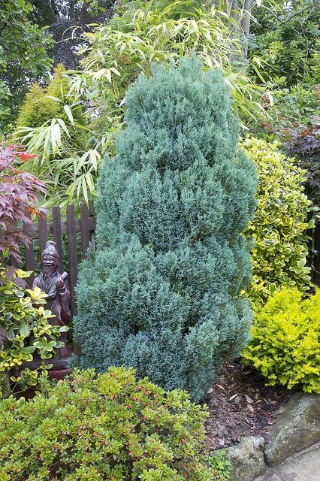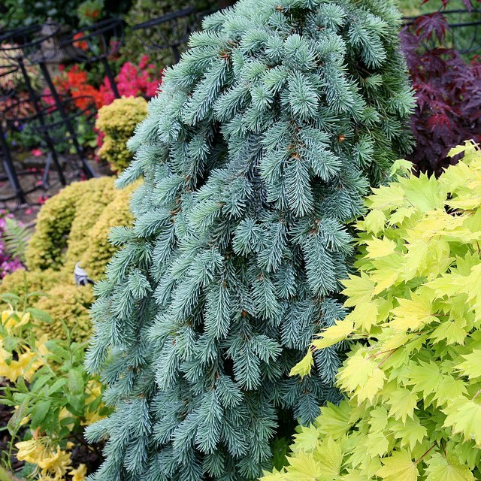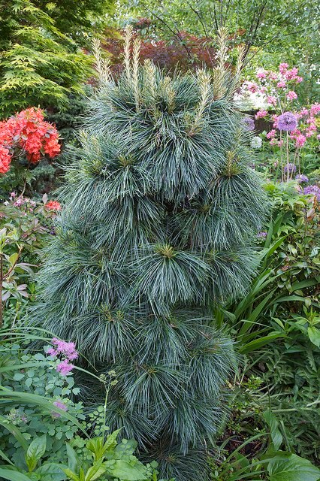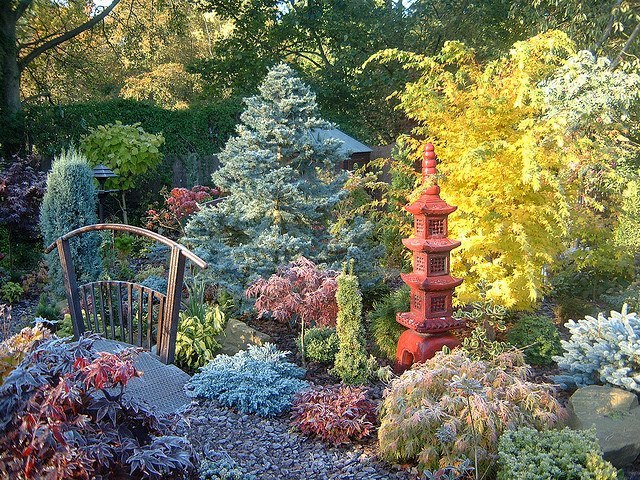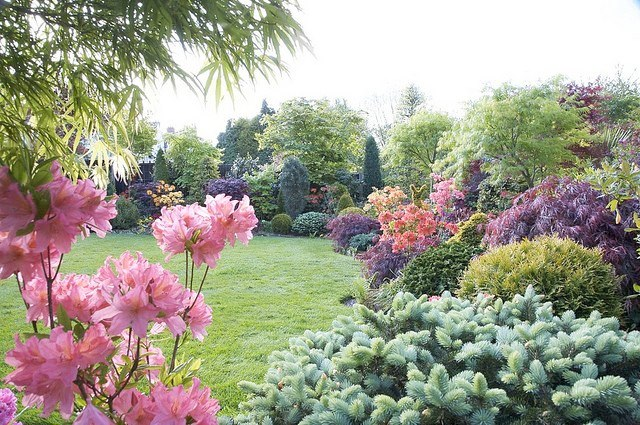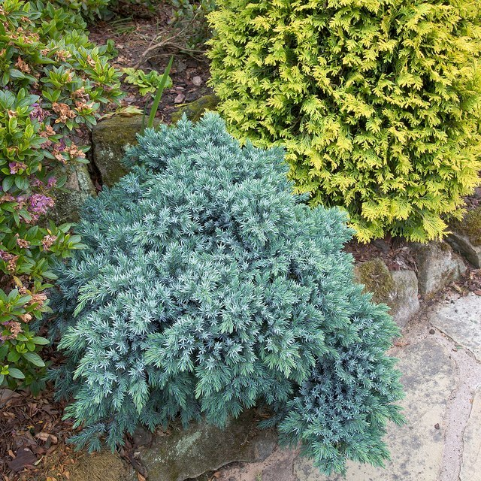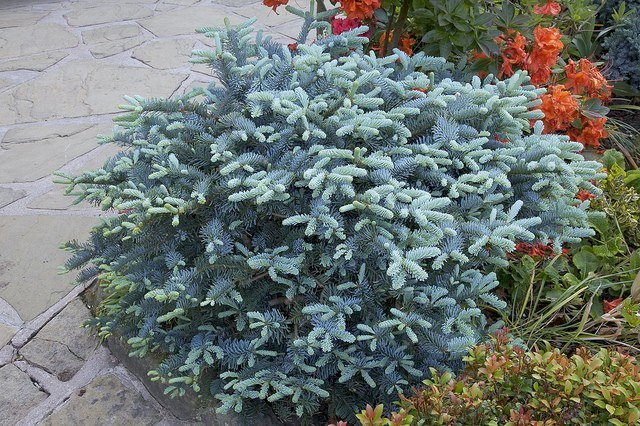Conifers
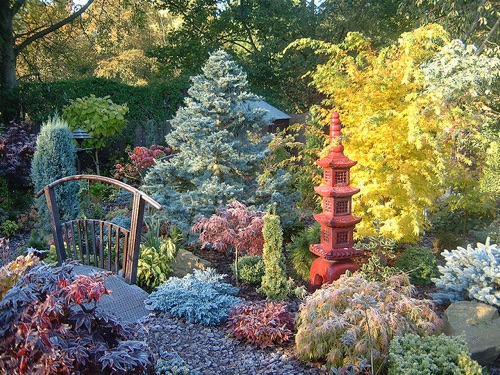
Conifers give all year round foliage colour and provide a lovely backdrop against which to show other plants. Many of the conifers we decided to select had yellow or blue foliage, however this criteria was not exclusive.
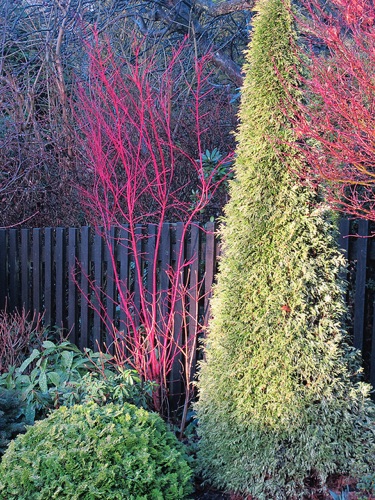
Yellow or gold conifers contrast well with most other colours in the garden. During winter they give a feeling of warmth to the garden like 'winter sunshine’, especially since some of gold colours become more intense.
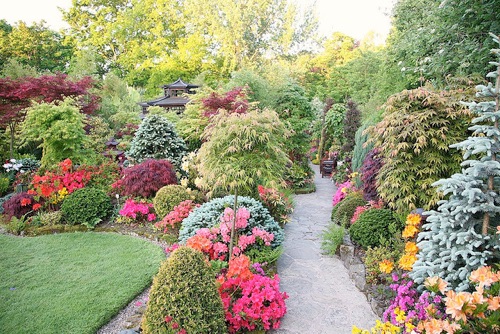
Blue conifers have distinctive shades of blue with variable amounts of green and silver. The lighter coloured new growth is particularly beautiful in spring. Blue conifers look especially stunning when contrasted with red or yellow coloured plants.
One of our current skills is keeping our collection of bright coloured conifers healthy and to size and in proportion. A crucial discovery that we had made about conifers was that for all their foliage to look healthy, without dieback, they need ‘all round’ light and therefore, in our replanting scheme, they would need to be allocated their own space. This would mean that maintenance of the garden would include checking each conifer every few months to ensure that other plants were not growing into the conifers and occluding light. Any pruning would need to be sympathetic and seamless so that neither the conifer or other plant looked obviously pruned. Furthermore, this care would lead to maintenance of clear definition of each plant. Our style of pruning an overgrown conifer, see: ‘Pruning conifers’
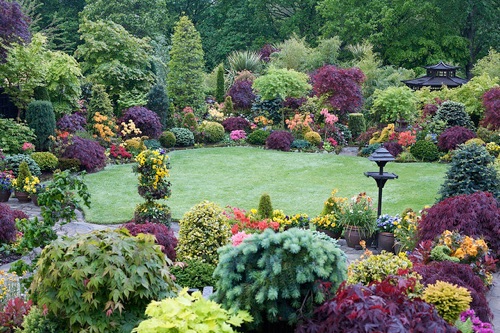
In 1982 we hadn’t thoroughly worked through our ideas about conifers and during the period 1982-1990 continued to experiment with them. We learnt what were the bad features and what were the good features. We discovered that certain varieties of conifer were totally unsuited to our garden. We planted a Leylandii hedge of 65 trees; however, six years later we removed them. We realized that they were totally unsuitable plants for our garden due to their excessive growth rate and ugly features.
By 1990 we had realized that the type of conifers we needed in the garden were ones with attractive, bright foliage throughout the seasons, and which could be maintained to size and look tidy after pruning once a year. Although many of the conifers we decided to select had bright yellow or blue foliage, however this criteria was not exclusive since we were aware of several other varieties of conifer would play a role, e.g. Chamaecyparis obtusa Nana with its bottle green foliage and Chamaecyparis Lawsoniana Summer Snow with its white young leaves. We also decided to select several conifers from each of the Taxus, Abies and Thuja genera of coniferous trees.
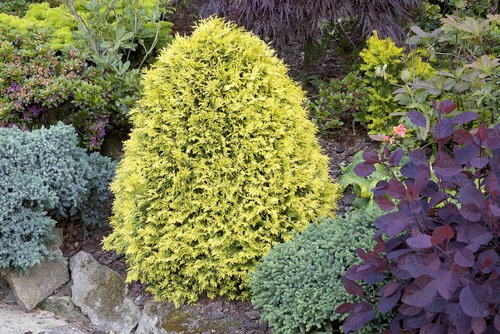
Thuja occidentalis 'Sunkist'
Yellow and gold conifers
Stardust is is very similar to Chamaecyparis lawsoniana 'Golden Wonder'. It is a conifer which has bright golden-yellow foliage that maintains good colour throughout the year and looks even more stunning when contrasted against other colours such as shades of red or blue.
The 'Stardust' could ultimately reach 9 metres in height. However we have maintained ours to a height around 2 metres!
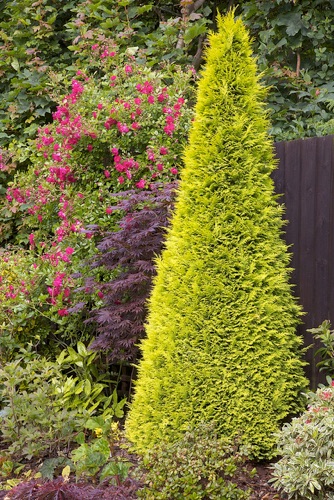
Chamaecyparis lawsoniana 'Stardust'
(Lawson cypress 'Stardust')
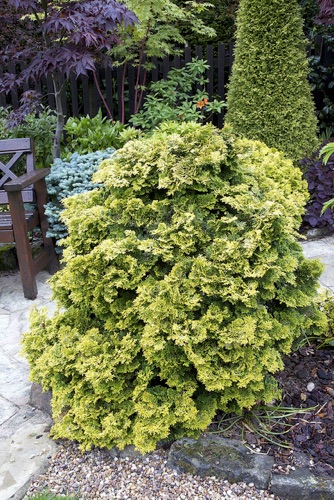
Thuja occidentalis 'Trompenburg'
(White cedar)
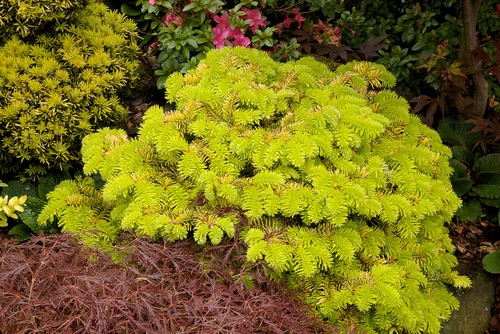
Abies nordmanniana 'Golden Spreader' with the new spring growth
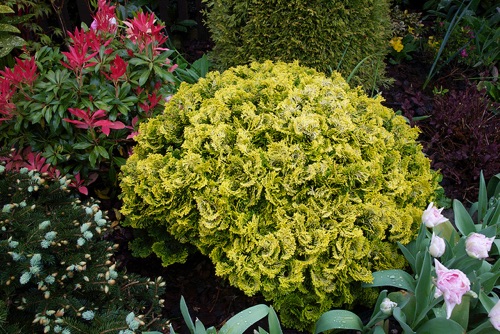
Chamaecyparis obtusa 'Nana Aurea'
(Golden False Cypress)
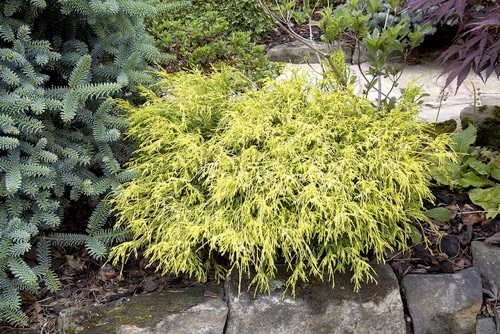
Chamaecyparis pisifera 'filifera aurea'
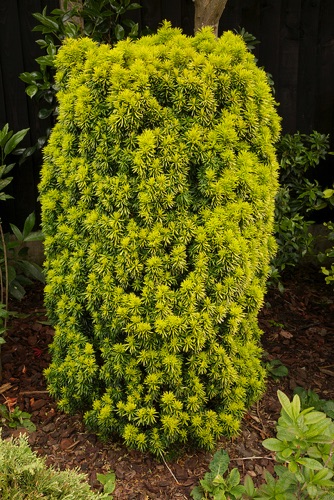
Taxus baccata 'Standishii' (Standish Yew)
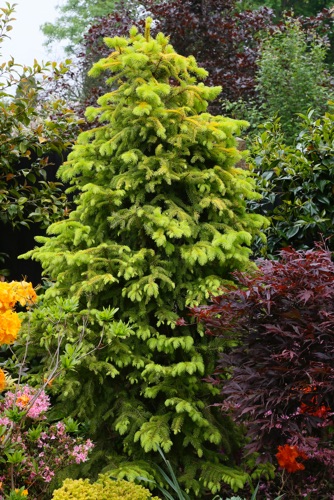
Picea abies 'Aurea Magnifica' (Magnificent Golden Norway Spruce)
Picea abies 'Aurea Magnifica' (Magnificent Golden Norway Spruce)
We like the slightly drooping habit of the branches and the light green new growth in spring contrasting with the darker older foliage.
By autumn the foliage of this 'Aurea Magnifica' will become more golden than the new conifer foliage in this photo.
Like many garden plants the 'Aurea Magnifica' looks at its best when contrasted with other plants with a different colour, shape or texture such as these azalea flowers and the dark red acer palmatum.
Blue conifers

Abies pinsapo 'Glauca' (Spanish fir)
Beautiful raspberry colored buds are borne in spring which become blunt and yellow - green in colour when erupting. The needles radiate out around the branches in a prominent fashion. As in this photo, after the new growth of spring, the new foliage by early summer has become a green-blue colour however, by winter this foliage becomes more blue.
This garden conifer could grow to 7 metres. However we maintain ours to around 1.5m and keep it to an enhanced conical shape.

Pinus wallichiana 'Nana' (Dwarf Himalayan Pine, Butan Pine)
We like the long needles of this decorative pine and many of our visitors also mention how delightful they are to see it and to touch it! The needles around 5 inches long and in fascicles(whorls) of five. They are three-sided, blue on the two upper sides and green and smooth on the lower, creating a very soft, silvery-blue appearance.
In order to keep the plant to a small size, in late spring we cut off about 4/5 of the length of the soft leggy new growth shoots which quickly heal. Sap loss is minimal, barely visible and quickly ceases.
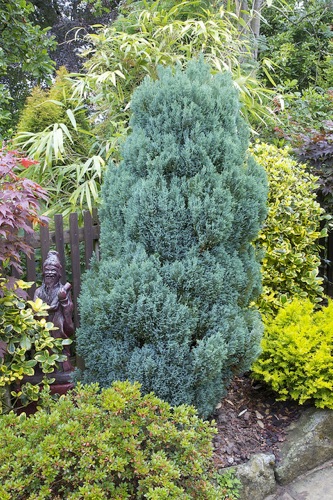
Chamaecyparis lawsoniana 'Ellwoodii' (Lawson false cypress)
It is a compact densely branched, 'relatively slow' growing conifer with relatively soft, feather-shaped foliage comprising silver-blue scaled 'needles'.
This conifer is more than 25 years old. We like the steel-blue colour of this conifer and have found our own way of keeping it to a suitable size!
Our 'Ellwoodii' was planted in 1992 and we maintain it to a height around 1.8 m. However, unpruned adult specimens could reach a height of about 4m and width 1.5m.
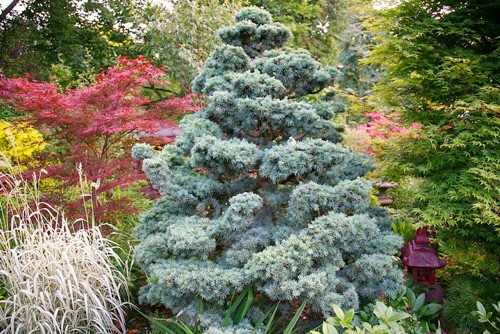
Blue Atlas Cedar (Cedrus atlantica Glauca)
This cedar variety is native to North Africa's Atlas Mountains and is often considered to be one of the most dramatic of all large blue conifers. In parkland planting it is often a magnificent, large, specimen evergreen conifer with elegant wide spreading branches. It has silver foliage, the needles becoming blue with age.
It is likely that a Blue Atlas Cedar Atlantica would quickly become too large for an ordinary garden and most would need removing 10-15 years after planting! At full maturity it could reach a height of 30–40 m (around 100ft), with a trunk diameter of 1.5–2 m (4-6ft)! However, we planted this blue cedar in 1993 and have kept it to the height and shape by regular pruning. In this picture it has a height of 2.5m (8ft) and we have no intention of letting it outgrow its present space!

Abies procera 'Glauca Prostrata'
Formerly Abies magnifica 'Prostrata'. A low spreading steely-blue conifer with prostrate branches . A cultivar of the Noble Fir, it grows slowly but would grow to 1.5m across in 10 years without pruning.
This abies apparently needs moist conditions and protection from drying winds; however, ours is in full sun and always seems to look tidy! Like other of our abies cultivars it has significant ability to produce new growth from 'old' wood.

Picea mariana 'Nana' - Dwarf black spruce
Nana' is a very slow-growing evergreen dwarf conifer with dense rounded habit, with blue-grey-green, needle-like foliage.
Planted in 1992, this conifer now measures 50cm x 50cm x height 20cm. Although it is always tidy, we occasionally prune very slightly to keep it to a uniform shape.
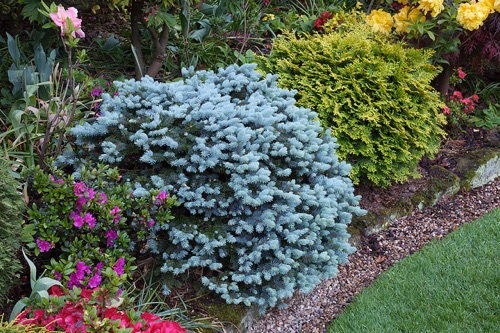
Picea pungens "Glauca Globosa" - Dwarf Colorado spruce
Although Colorado spruce originates in the Rocky Mountains of Canada and the USA it has been in wide cultivation in Europe and its colder regions. Glauca Globosa is one of its many varieties sought after for its steel-blue, prickly needles.
Although Colorado spruce originates in the Rocky Mountains of Canada and the USA it has been in wide cultivation in Europe and its colder regions. Glauca Globosa is one of its many varieties sought after for its steel-blue, prickly needles.
The plant makes beautiful tiered branches that predominantly spread to the sides. Its ultimate height would be about 1.5m in maturity, however although we planted the picea in this picture in 1992 we have kept it to a relatively small size by once yearly gentle winter pruning.
This Spruce likes neutral to slightly acidic soil and full sun and is hardy to about -40°C!
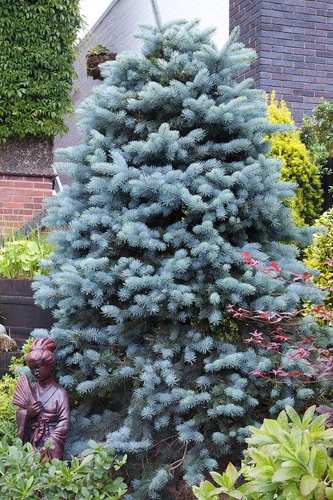
Picea pungens 'glauca group' - Colorado spruce
Regarding Picea pungens we have three different cultivars in our garden which are all very similar and these are 'Hoopsii', 'Thompson' and 'Kosteri' and we are not certain which cultivar is which!
Regarding Picea pungens we have three different cultivars in our garden which are all very similar and these are 'Hoopsii', 'Thompson' and 'Kosteri' and we are not certain which cultivar is which!
Although Colorado spruce originates in the Rocky Mountains of Canada and the USA it has been in wide cultivation in Europe and its colder regions. It is hardy to about -40°C! Spruce like neutral to slightly acidic soil relatively well drained soil and full sun.
It forms a neatly shaped tree with rich branching from the ground.
It has relatively slow growth but could eventually reach 10m or more without pruning! Luckily picea pungens responds well to once yearly gentle winter pruning and, despite planting in 1992, we have kept ours to a height of about 2m.
Other Colour Conifers
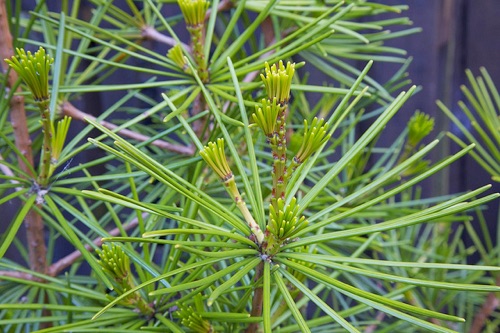
Sciadopitys verticillata (Japanese Umbrella Pine or Koyamaki)
Sciadopitys verticillata is a very unique Japanese conifer which is like a “living fossil”. It is the only member of its family and genus and has no close living relatives. It is thought to have existed for over 230 million years. It has bold green foliage and is slow growing.
Sciadopitys verticillata is a very unique Japanese conifer which is like a “living fossil”. It is the only member of its family and genus and has no close living relatives. It is thought to have existed for over 230 million years. It has bold green foliage and is slow growing.
If unpruned it usually reaches a height of 1.5-5.5m after 10 years however, it is able to reach a maximum height and spread of 20m x 8m.......but as you have guessed we would not let it grow that large in our garden!
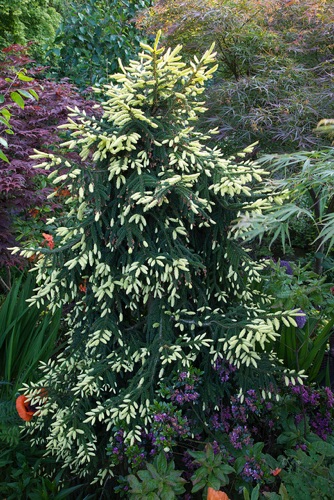
Picea Orientalis 'Aurea Spicata' (Aurea Oriental spruce)
In late spring and early summer this lovely conifer has golden-yellow new growth contrasting beautifully with the older green foliage. It has an elegant shape due to the slightly drooping branchlets with short, blunt-tipped needles which are closely-packed.
In late spring and early summer this lovely conifer has golden-yellow new growth contrasting beautifully with the older green foliage. It has an elegant shape due to the slightly drooping branchlets with short, blunt-tipped needles which are closely-packed.
A mature tree could reach 20m in height however we planted this tree in 1994 and we keep it to around 2m by pruning to shape and form once per year.
Four Seasons Sitemap
© All Rights Reserved
Please do not download our photo images from this website to use for publication or any commercial reason without our permission.
Images may not be copied, reproduced, published or distributed in any medium without the expressed written permission of the copyright holder.















